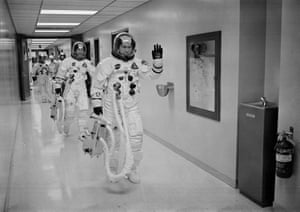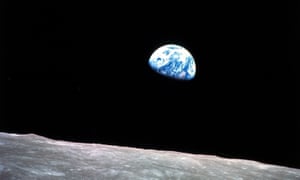Main image: The photo was taken on Christmas Eve in 1968 and remains one of the most enduring space images of all time. Photograph: William Anders/AP
by Luke O'Neil
Picture
the Earth from space: the striking bright blue of the oceans, the
swirls of white clouds. It’s really very easy for any of us to conjure
this image in our minds today, but it wasn’t always so.
The Earth in all its splendid majesty was seen for the first time on Christmas Eve 50 years ago, when it was captured in an image that changed not only the way we think about space, but how we think about Earth and our place in the universe.
The picture was taken in the midst of the space race. Major William A Anders and the rest of the crew aboard the Apollo 8 mission were keenly aware of the pressures of their mission to orbit the moon, laying the groundwork for the first lunar landing that was still to come.
The Earth in all its splendid majesty was seen for the first time on Christmas Eve 50 years ago, when it was captured in an image that changed not only the way we think about space, but how we think about Earth and our place in the universe.
The picture was taken in the midst of the space race. Major William A Anders and the rest of the crew aboard the Apollo 8 mission were keenly aware of the pressures of their mission to orbit the moon, laying the groundwork for the first lunar landing that was still to come.
A few years back, speaking at the Johnson Space Center as part of a BBC documentary on the mission, Anders recounted the experience. As they ascended into space he snuck a glimpse of Australia, he said. He tried to peak at his hometown of San Diego but it was covered by fog.
Once they were a safe enough distance from Earth for further sightseeing, Anders perceived the glowing orb in the distance behind him, but the enormity of it didn’t register.
“That’s when I was thinking ‘that’s a pretty place down there,’” Anders said. It was “kind of like the classroom globe sitting on a teacher’s desk, but no country divisions. It was about 25,000 miles away where you could still recognize continents.”
After two to three orbits around the moon, he and the crew began shooting photographs.
"To see the Earth as it truly is, small and blue and beautiful in that eternal silence where it floats"
“I don’t know who said it, maybe all of us said, ‘Oh my God. Look at that!’” Anders said.
“And up came the Earth. We had had no discussion on the ground, no briefing, no instructions on what to do. I jokingly said, ‘well it’s not on the flight plan,’ and the other two guys were yelling at me to give them cameras. I had the only color camera with a long lens. So I floated a black and white over to Borman. I can’t remember what Lovell got. There were all yelling for cameras, and we started snapping away.”
Looking back on it year’s later, Frank Borman, the mission’s commander, said words failed him and his crew in the moment.
“I don’t think we captured, in its entirety, the grandeur of what we had seen,” he’s said.

On Christmas Day in the New York Times, the poet Archibald MacLeish, who like everyone else still on Earth had only as yet seen images broadcast on television black and white, put himself in the astronauts’ seats, attempting to capture the awe of what the Apollo 8 crew other astronauts would later experience, and has been called the “overview effect”.
“To see the Earth as it truly is, small and blue and beautiful in that eternal silence where it floats, is to see ourselves as riders on the Earth together, brothers on that bright loveliness in the eternal cold – brothers who know now they are truly brothers.”
Suddenly Earth no longer seemed the center of the universe, he wrote. Logically of course many people had long known this, but Anders’ photograph had a way of confirming it.
Writers and dreamers and scientists would return to that feeling of celestial displacement often over the years. In a 1983 short story Human Moments in World War III, Don DeLillo places a character in Anders’ viewpoint.
“The view is endlessly fulfilling,” he wrote. “It is like the answer to a lifetime of questions and vague cravings.”
After the mission was complete the photo would go on to grace the final issue of Time Magazine of the year, with the caption: “Dawn.”
Broadcasting home, the Apollo 8 crew read from the Book of Genesis as the Earth rose before them, contrasted against the lifeless moon.
“In the beginning God created the heaven and the Earth,” Anders said.
For the astronauts, and the rest of us back on Earth, it was as if something new had been born and we could all perceive it for the first time together. We saw ourselves.

No comments:
Post a Comment